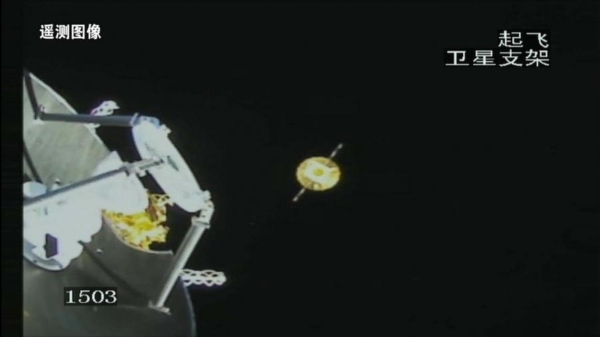China's relay satellite operating smoothly, ready to support global lunar missions
Source: Xinhua | 2025-05-20 | Editor:jennifer

This photo taken by satellite bracket camera of Long March-8 carrier rocket on March 20, 2024 shows the Queqiao-2 relay satellite (C) successfully separating from the carrier rocket with its solar wing and antenna successfully unfolded. (China National Space Administration/Handout via Xinhua)
Queqiao-2, China's relay satellite for its lunar landing missions, is set to support future moon exploration endeavors by other countries, according to the country's Deep Space Exploration Lab.
The satellite, which supported Earth-moon communications for China's Chang'e-6 mission that has retrieved samples from the moon's far side, will provide relay services for lunar missions from China and other countries, the lab said on Monday.
Launched in March last year, Queqiao-2, also known as Magpie Bridge 2, is equipped with three scientific payloads -- an extreme ultraviolet camera, a two-dimensional-coded energetic neutral atom-imager and an Earth-moon very long baseline interferometry (VLBI) experiment system.
The satellite has been stably operating in orbit for 14 months, performing scientific tasks including large-scale imaging of Earth's plasma and magnetosphere layers, and VLBI experiments in the Earth-Moon system, according to the lab.
The satellite's extreme ultraviolet camera captured the first global 83.4-nanometer ionosphere image, providing crucial data for studying the impact of solar activity on the plasmasphere.
The satellite's VLBI experiment system, in coordination with the Shanghai 65m Radio Telescope, extended the observation baseline to 380,000 kilometers and successfully observed deep-space targets like radio source A00235 and the Chang'e-6 orbiter.
Queqiao-2 is poised to play a crucial part in the country's future Chang'e-7 and Chang'e-8 missions.
China plans to launch the Chang'e-7 mission around 2026 to explore the environment and resources of the south pole of the moon. The Chang'e-8 mission, set for around 2028, will conduct experiments for the in-situ utilization of lunar resources.
You May Like
-
China launches space computing satellite constellation
China launched a Long March-2D carrier rocket on Wednesday, placing a space computing satellite constellation into space.
InKunming 2025-05-14 -
China builds three-satellite constellation in Earth-moon spa...
China has successfully established the world's first three-satellite constellation based on the Distant Retrograde Orbit (DRO) in the Earth-moon space.
InKunming 2025-04-17 -
China successfully launches new satellite group
China sent a new satellite group into space on Thursday from the Taiyuan Satellite Launch Center in north China's Shanxi Province.
InKunming 2025-01-23 -
China places 1st satellite of year into orbit
China launched a Long March 3B carrier rocket early on Tuesday morning to deploy an experimental satellite into space, fulfilling the country's first space miss...
InKunming 2025-01-08 -
China builds large commercial radar satellite constellation
The large-scale application of a Chinese commercial radar remote sensing constellation composed of 12 satellites began on Monday, according to PIESAT, a Beijing...
InKunming 2024-12-25 -
China launches new satellite group
China sent a new group of satellites into space on Tuesday from the Taiyuan Satellite Launch Center in northern Shanxi Province.
InKunming 2024-12-17 -
China's commercial satellite constellation to provide Brazil...
China's commercial satellite constellation Spacesail will provide satellite communication services to Brazil and broadband internet access to the country's remo...
InKunming 2024-11-21 -
First microsatellite developed by China, Russia college stud...
On Tuesday morning, a microsatellite, the first of its type jointly developed by Chinese and Russian universities, was successfully launched from the city of Bl...
InKunming 2024-11-06 -
1st reusable satellite payloads returned
Scientific payloads returned from the maiden flight of China's first reusable satellite were delivered to their owners on Thursday.
InKunming 2024-10-25 -
China launches new remote-sensing satellite group
China launched a Long March-2C carrier rocket on Wednesday to place a new group of remote-sensing satellites in space.
InKunming 2024-10-23







